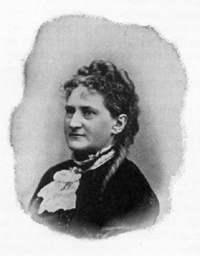THE HIGHER WOMANHOOD. *
By MRS. CAROLINE F. CORBIN.

|
| MRS. CAROLINE F. CORBIN. |
The women of this generation have been busy with the intellectual and economical development of the new era. In so doing they have acted under an inspiration as true as that which fashions the rocky crust of the earth before it clothes the crags with verdure or brings forth the flowers which embellish the plain. But when the birth throes of the new advent are over, the stir and excitement of it all past, and humanity shall settle down to the fully developed conception of woman as no longer a slave or an inferior, but the equal of man, a creature with her own needs, her own prerogatives, her own destiny, not indeed identical with man, but in every respect of equal worth and dignity, then will it be seen that even from the beginning the emotional and spiritual nature of woman has been God's crowning gift to the race; that even as a serf or slave, in Bedouin tent or Asian harem, fettered, circumscribed and despised, she was still the fountain of life, the helpmate and inspiration of man, the sybil, the seer, the prophetess, the exponent of that divine principle of love on which the progress and culmination of the race wholly depended. The germ of her great destiny was there, biding its time in darkness and obscurity. The magnetic impulse of the woman soul was even then the promise of God to the race, of its future development and flowering, and that without it the career of man, even in the material and intellectual phases of life, must have been abortive, impossible.
I look abroad over the marvelous scenes of this Exposition, scenes never before equaled in fairy tale or dream of the Arabian Nights, which Shakespeare's fancy but faintly outlined in that wondrous scene of "cloud-capped towers and gorgeous palaces and solemn temples," which is such a description of our beloved Exposition and its final destiny, as no other hand but his could have written. I look, I say, upon this wondrous scene of enchantment which men claim as their unaided achievement, and I ask, is it in truth the work of man alone? I go back to the quiet homes, the studios apart from the noisy scenes of life, the work shops, the forges, and seeing these indomitable toilers at work, these Cyclops, these peers of the ancient Hercules, I ask whence came the inspiration which fires their imagination, which nourishes their fancy, which expands heart and soul to these new and grand conceptions of form and life and achievement; and I find in the inner recesses of each man's heart the energizing force of passion some gentle face of woman, some tender ministry of love which tempers the nerves of steel to greater endurance, and exalts and warms and quickens the whole nature. There is no worthy work of man which lifts itself to heaven over the broad earth today which has not behind it, giving it life, force and inspiration, the fecund, nourishing soil of womanhood. Nor, as the ages go on, and woman achieves grand and glorious successes in the outer world, shall we ever find that they can do this unaided by man. In every woman's work that is worthy of exalted fame, will be found the evidence of that strong support, that steady guidance, that supreme aspiration that man alone can minister.
In conclusion, I wish to give you the strong figure and example of what I have tried to say in this discourse. Go with me to the Midway Plaisance and look at the Samoan houses, the village of the South Sea Islanders, the huts of the Esquimaux and Laplander, and then stand with me in the Court of Honor, amid all its sublime and unearthly beauty, its gorgeous flower-encircled domes and its matchless fountains, its colonnades and porticoes, the grandeur of its Peristyle, the airy grace and beauty of its architecture, the stately columns, the majesty of its Statue of the Republic; measure, if you can, standing under the blue of the sky, with the blue of the lake spread out before you, the progress, the achievement which humanity has made from the Midway to where we stand. I tell you as one who speaks from the inmost councils of nature and God that one undivided half of all this achievement belongs to woman. It is immutably, indefaceably here, and it is an exhibit of woman's work beside which every other exhibit of woman's hand-craft in this Exposition, noble and beautiful as many of them are, is paltry and insignificant.

[Page 326]
Mrs. Caroline Fairfield Corbin is a native of Connecticut. She was born November 9, 1836. Her paternal and maternal ancestry are well known New England families. She was graduated from the Brooklyn Female Academy, since known as Parker Collegiate Institute of Brooklyn and Long Island. She has traveled extensively in this country and Europe. She married, in 1861, Calvin R. Corbin, Esq. She has had six children. Her special work has been in the interest of reform in the relations between men and women. Her principal literary works are "Rebecca, or Woman's Secret," "The Marriage Vow," and other works. In religious faith she is a Trinitarian Christian, and a member of the New England Congregational Church. In her early years Mrs. Corbin advocated Woman's Suffrage, but deeper study and experience convinced her that the doctrine implied a low materialistic idea of the value and destiny of women, and she has in recent years written many pamphlets in opposition to the political rights of women. Her postoffice address is 597 Dearborn Avenue, Chicago. Ill.
* The article as here given includes but the concluding portion of the address delivered in the Woman's Building.